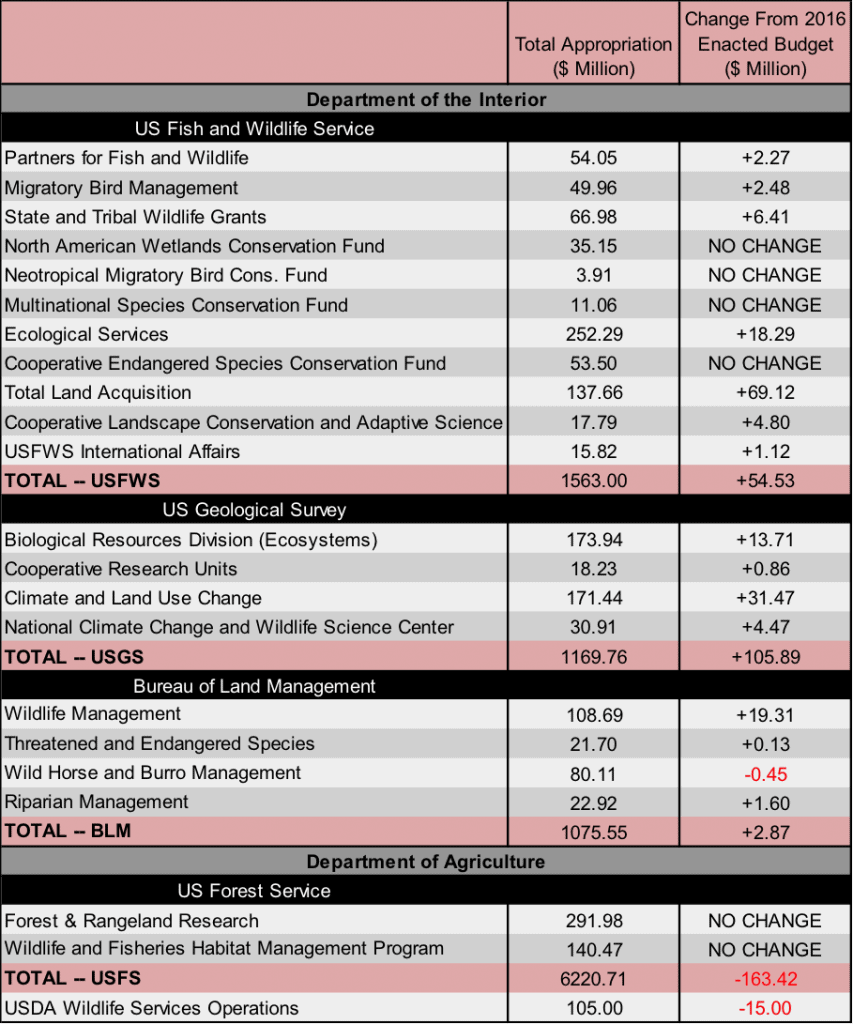Share this article
President’s budget requests funds for conservation programs
This past Tuesday, the Obama administration released its eighth and final budget request. The Executive budget proposal is the first step of the annual federal budgeting process, which will continue into September and apply to fiscal year 2017.
The president’s budget included increased and sustained funding for several key natural resource programs and agencies, with total appropriations of $1.6 billion for the U.S. Fish and Wildlife Service, $1.2 billion for the U.S. Geological Survey, and $1.1 billion for the Bureau of Land Management – increases of $55 million, $106 million, and $2.9 million from the 2016 enacted budget levels, respectively.
Highlights include a $14 million increase in funding for sage-grouse conservation, under the BLM, for continuing implementation of 68 sage-grouse plans and addressing new information and challenges. This program increase brings the total budget for sage-grouse and sage steppe ecosystem conservation to $74.2 million. The budget also calls for an increase in $3 million for USGS to expand research on sage steppe landscape restoration and adaptive management.
The Obama administration also addressed invasive species with a $2.5 million increase for USGS Invasive Species Program research, with specific mention of molecular tools for detecting otherwise hard-to-find invasive species.
A $6.4 million increase for State and Tribal Wildlife Grants brings its total funding to $67 million. State and Tribal Wildlife Grants which support Wildlife Action Plans and allocate funding to States for protecting species and habitats of greatest concern, including non-game species and those which are not listed as endangered. This program’s inception and continued funding is an effort spearheaded by the Teaming With Wildlife coalition, of which The Wildlife Society is on the steering committee. The coalition brings together wildlife professionals to advocate for increased State and Tribal Wildlife Grant funding on Capitol Hill at its annual fly-in event. Registration is still open for 2016.
Language in the proposal would establish a new rule pertaining to National Wildlife Refuge damage cost recovery. As it stands, if damage is done to living or nonliving resources at a National Wildlife Refuge the individual responsible can be fined criminally, but the fine does not get allocated to repair or recovery. The proposed rule authorizes USFWS to collect compensation from responsible parties. The USFWS began requesting such a rule as early as 2014, and it was discussed – but ultimately not voted on – as an amendment to the Bipartisan Sportsmen’s Act.
In regard to wild horse and burro management, administrative changes in the USFS budget proposal would authorize transfer of up to $10 million from USFS appropriation to BLM for removal, preparation, and adoption of excess wild horses and burros. The BLM budget includes language to more efficiently adopt out and transfer horses and burros to other public entities that require domestic work animals. Each animal removed from public care could save taxpayers almost $50,000. The Wildlife Society’s Government Affairs & Partnerships team is actively involved in the National Horse and Burro Rangeland Management Coalition.
This Executive budget is the first time this administration, or any administration, has not reduced funding for any farm bill programs. The farm bill is an amalgamation of programs including the Conservation Stewardship Program, Environmental Quality Incentives Program, Agricultural Conservation Easement Program, and Regional Conservation Partnership Program.
As many of their programs address endangered species, increased overall funding for USFWS would work to conserve and recover them. In a budget briefing, the USFWS stated that they have now delisted more species than any previous administration, and are on track to delist more species due to recovery than any other administration combined. The request for the Cooperative Endangered Species Fund, which provides grant funding for States and Territories, remains unchanged from 2016, with $53 million in appropriations.
The president’s budget proposal also includes full funding for the Land and Water Conservation Fund, at $900 million. This amount has only been appropriated once in the program’s 50-year history.
The Executive budget is only the first step to the budgeting process. Congress must come to an agreement on spending limits and allocations, develop 12 appropriations bills pertaining to various departments and agencies, pass those bills through both the House and the Senate, and then have them approved by the president. If all goes according to plan, the 2017 budget will become Public Law by Oct. 1.
For more information on the federal budget process and how you can get involved at every step, refer to the Policy Toolkit, provided by The Wildlife Society in support of the Conservation Affairs Network.
Header Image: ©Lynn Phelps









